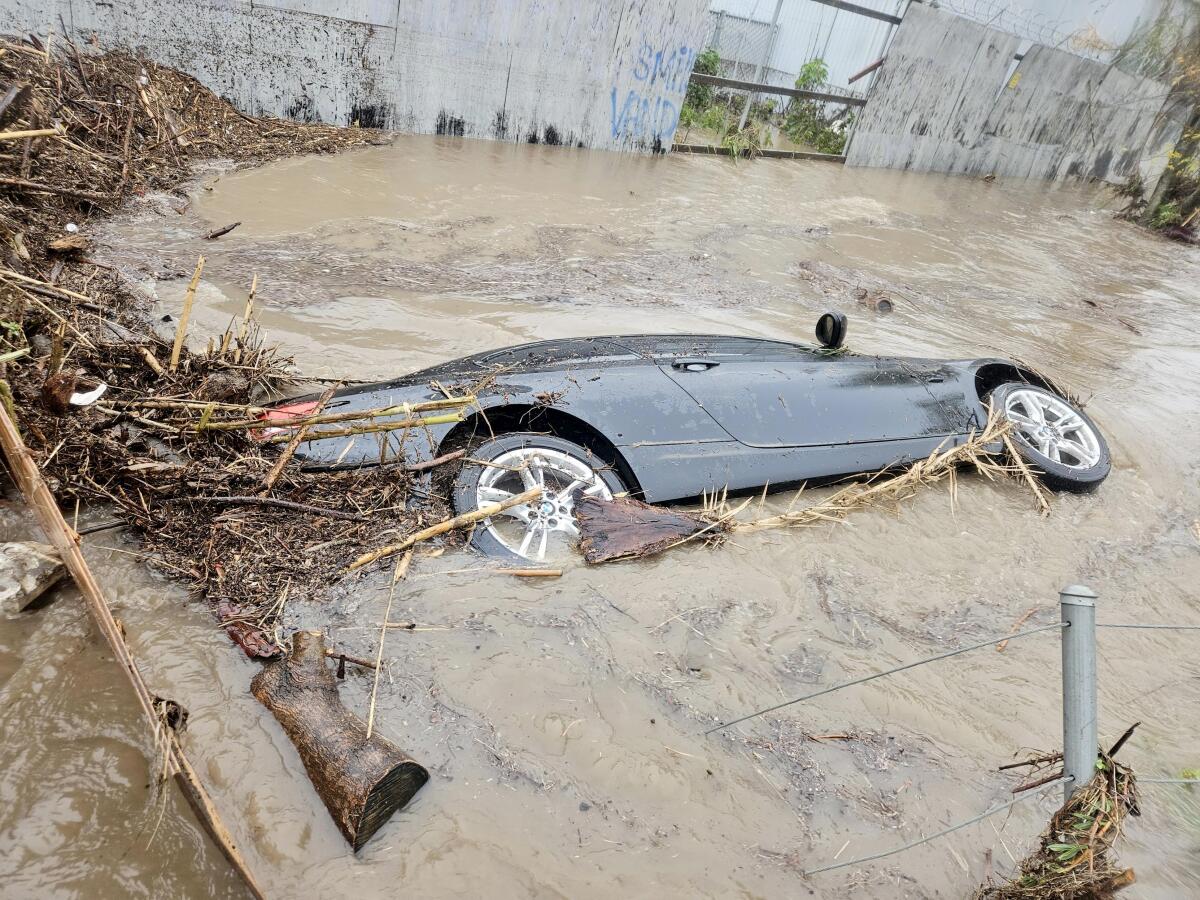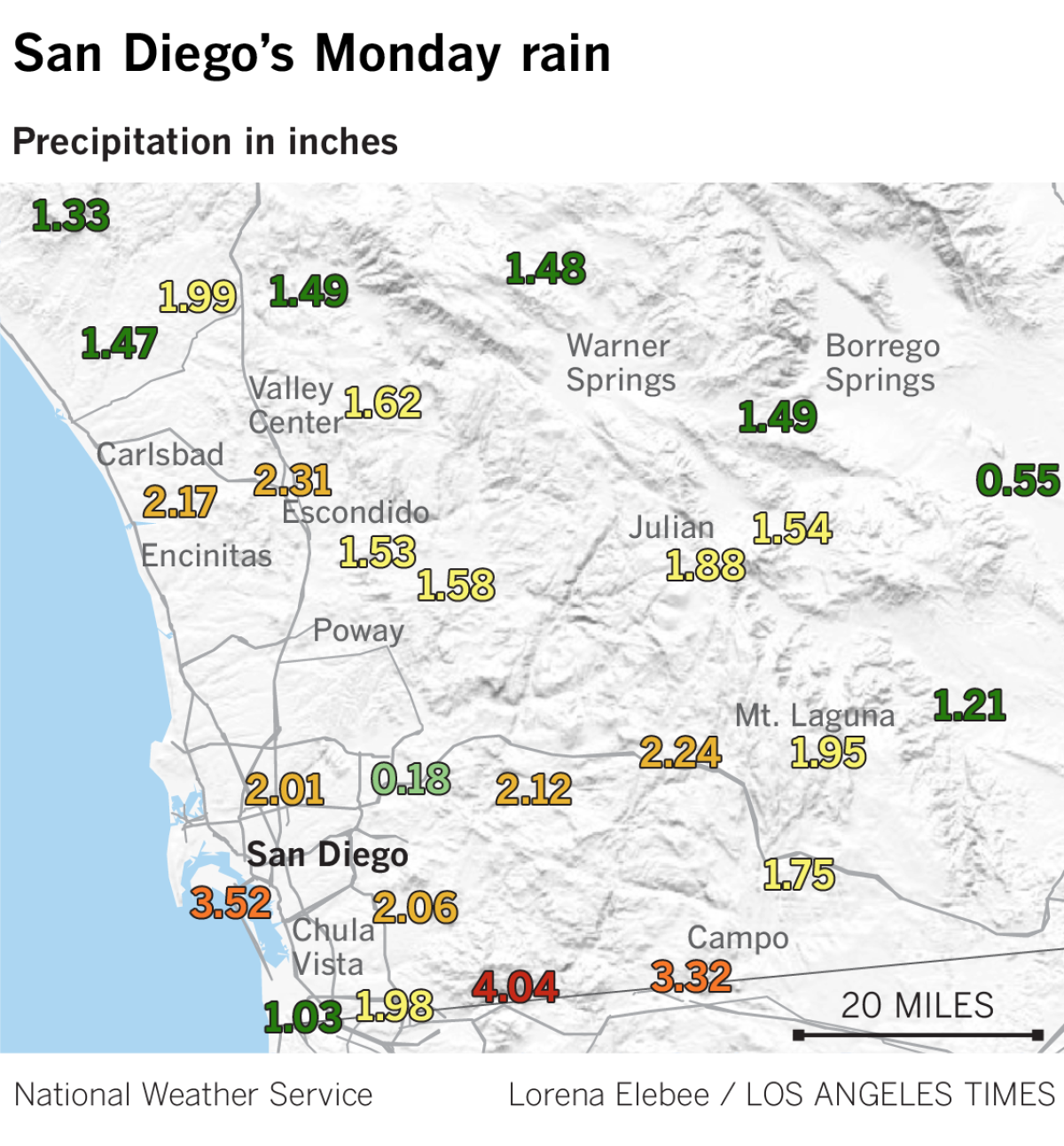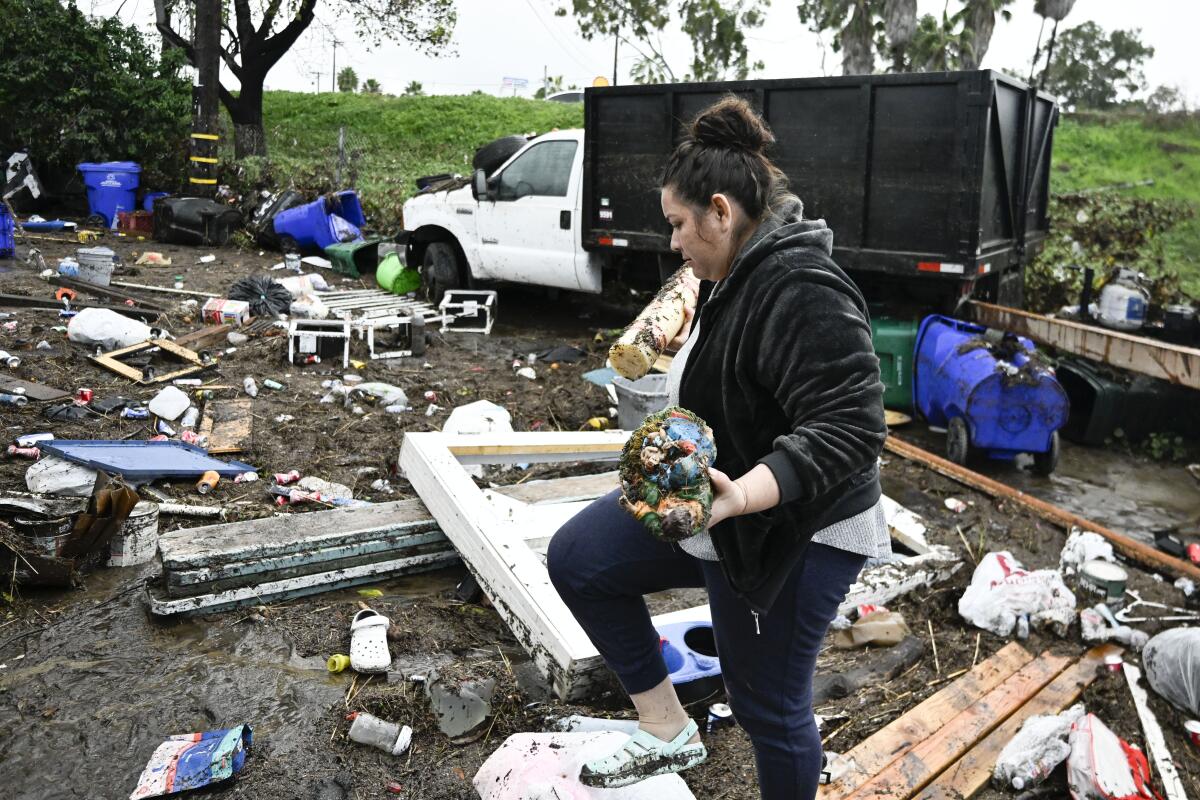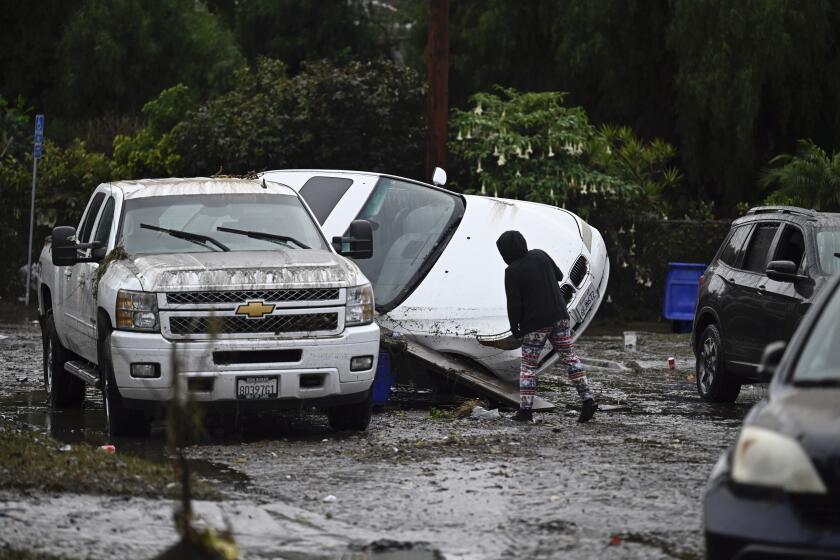‘Thousand-year storm’ leaves San Diego reeling from punishing rainfall, floods

- Share via
In a matter of minutes Monday morning, communities across southeastern San Diego were transformed into disaster zones: Families fled their homes in chest-deep floodwaters; vehicles were swept downstream as roads became rivers; residents cried for help from their rooftops.
A deluge of rainfall from what city officials are calling a “thousand-year storm” forced hundreds of rescues, flooded an untold number of homes and businesses and caused millions of dollars in estimated damage. The floodwaters had mostly receded by Tuesday afternoon, revealing the devastating aftermath of California’s latest climate emergency — and leaving hundreds without housing and transportation, and with ruined valuables and personal belongings.
“The damage and the impact was absolutely devastating,” San Diego Mayor Todd Gloria said at a Tuesday news conference. “Entire lives changed in just a few minutes.”
“The amount of water that we saw yesterday would have overwhelmed any city drainage system,” he said. “This dumping of rainwater is unprecedented in most San Diegans’ lifetimes. None of us alive have seen anything quite like this.”

More than 4 inches of rain fell in several areas in and around San Diego on Monday — much of it in just a few hours — a historic rainfall event, according to Elizabeth Adams, a meteorologist with the National Weather Service in San Diego. The airport recorded 2.73 inches, more than its typical total for the entire month of January.
“That is not only the wettest January day on record, but it’s the fourth-wettest day of any calendar day” for San Diego, Adams said. Many areas saw rainfall rates well above three-quarters of an inch per hour. Over half an inch per hour can easily cause dangerous flash flooding.
Heavy rains early Monday caused significant flooding across San Diego, closing major roadways, shutting down bus lines and causing power outages.
“It’s a ton,” Adams said. “Pretty much anywhere in the country that receives 3 to 4 inches in a three- to four-hour time period is going to see flooding.”
Parts of San Diego were completely inundated.
The city’s southeastern neighborhoods, including Southcrest, Mountain View, Encanto, Logan Heights and San Ysidro, saw some of the worst damage.
Gloria said city and county leaders are focused on recovery. Both the city and county declared a local emergency. The mayor estimated, conservatively, that the storm caused $6 million in damage, but officials say assessments are far from complete.
Gov. Gavin Newsom on Tuesday proclaimed a state of emergency for San Diego and Ventura counties, both of which have been walloped by wet winter storms. At the end of December, torrential downpours in and around Oxnard caused similar damage. During that event, Oxnard saw rainfall rates of 3 inches an hour, one of the heaviest downpours ever recorded in the area.

The worry now is that the number of people displaced in San Diego could continue to grow in the coming days. Though no official figure was provided Tuesday, city leaders said they estimated hundreds had been forced from their homes, at least temporarily.
“What was generally assumed to be the impact yesterday … was probably an underestimate,” said San Diego City Council President Sean Elo-Rivera, whose district includes some of the communities that saw the worst of the flooding. He said he visited many of those residents early Tuesday, touring a whole apartment complex that took on water, likely displacing dozens of families.
The American Red Cross is operating two emergency shelters at Lincoln High School and Bostonia Recreation Center. As of Tuesday, the nonprofit said 18 households — more than 50 people — had registered to stay. But with so many people probably still returning home after fleeing, Elo-Rivera said he expected those numbers to rise. City and county officials are asking residents to fill out a voluntary survey about flood damage.
“I think it’s going to take a little bit more time to realize the extent of the damage,” Elo-Rivera said.
On Monday afternoon, Manuel Deleon was unexpectedly called back to the office during his shift driving a tow truck — only to find the office flooded. Roaring water had swept away his personal vehicle.
“The water was out of control,” said Deleon, 47. “My car slipped with the mud and went right into [a nearby] ditch and it was just fully submerged.”
Deleon, whose 2007 BMW was one of dozens of cars carried away in the flash floods, said he wasn’t sure how he’d get to work in the coming days. He attempted to clean the soggy and caked-in mud from the interior, but that was a lost cause.
“This rain took everybody by surprise,” he said. “It’s crazy.”
San Diego Fire Chief Colin Stowell said his crews made at least 150 rescues Monday, in addition to 30 animal rescues.
“We literally saw over 100 rescues in the Southcrest neighborhood alone,” Stowell said.
“Luckily we saw very few injuries and no fatalities,“ Stowell said, calling that feat “remarkable” given the extent of the emergency.
More than 1,000 people remained without power Tuesday, after widespread outages Monday, according to the San Diego Gas & Electric outage map.
Although much of San Diego was under a flood watch all day Monday, city officials said they were not prepared for the extent — and speed — of what came down.
“Nobody anticipated the severity of the storm,” Gloria said. “We got a lot more rain than [what was predicted] in a much shorter amount of time.”
He said he planned to meet with the National Weather Service to discuss the disparity between forecasts and what occurred but emphasized that his teams were currently focused on recovery.
Adams said the circumstances Monday ended up being a perfect storm for rare, heavy rainfall in San Diego: extreme atmospheric moisture and a storm path over its downtown — which forecasters warned residents about as soon as possible, she said.
Just after 8 a.m. Monday, the agency issued a flash flood warning for a stretch of coastal communities just south of Orange County, including Oceanside, Carlsbad and Vista. Soon after, a larger stretch of southwestern California was placed under a flash flood warning.

“We used pretty intense warnings,” Adams said. “We tried to really heighten the message … [that] this is a really dangerous situation that doesn’t happen in San Diego proper that often.”
The day before the storm, the National Weather Service’s forecast discussion warned that the ground, already saturated from storms over the weekend, could heighten flood concerns. But forecasters said it was still hard to predict how much rain would fall, and where.
By Monday morning, Adams said the situation developed rapidly, with that intense atmospheric moisture — what she called 250% to 350% of normal — and the direct storm path aligning.
That “really lead to torrential rainfall across the county, but especially focused on downtown and the surrounding neighborhoods,” Adams said.
City officials said these extreme circumstances are likely to become a new normal requiring more preparation, coordination and investment.
“This is called climate change. It is real, it is happening,” Gloria said, “and we experienced it yesterday in San Diego.”
Officials agreed that the city’s outdated stormwater drainage system, for which $2 billion of necessary work hasn’t been budgeted, didn’t help.
Elo-Rivera said he would like to see those much-needed funds allocated, and in an equitable way — noting that many of the communities affected most were working-class, with a majority of Latino and Black residents.
These communities “have long been under-invested in and divested in and ignored by the city,” he said. “Public investment in climate resiliency is incredibly important … [especially] prioritizing the communities that have been left behind and are most likely to be devastated by events like yesterday.”
More to Read
Sign up for Essential California
The most important California stories and recommendations in your inbox every morning.
You may occasionally receive promotional content from the Los Angeles Times.











